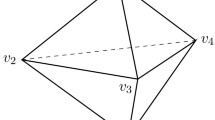Abstract
This paper describes a mechanism by which a traversally generic flow v on a smooth connected \((n+1)\)-dimensional manifold X with boundary produces a compact n-dimensional CW-complex \({\mathcal {T}}(v)\), which is homotopy equivalent to X and such that X embeds in \({\mathcal {T}}(v)\times \mathbb R\). The CW-complex \(\mathcal T(v)\) captures some residual information about the smooth structure on X (such as the stable tangent bundle of X). Moreover, \({\mathcal {T}}(v)\) is obtained from a simplicial origami map\(O: D^n \rightarrow {\mathcal {T}}(v)\), whose source space is a ball \(D^n \subset \partial X\). The fibers of O have the cardinality \((n+1)\) at most. The knowledge of the map O, together with the restriction to \(D^n\) of a Lyapunov function \(f: X \rightarrow \mathbb R\) for v, make it possible to reconstruct the topological type of the pair \((X, {\mathcal {F}}(v))\), were \({\mathcal {F}}(v)\) is the 1-foliation, generated by v. This fact motivates the use of the word “holography” in the title. In a qualitative formulation of the holography principle, for a massive class of ODE’s on a given compact manifold X, the solutions of the appropriately staged boundary value problems are topologically rigid.


Similar content being viewed by others
Notes
i.e., compact 1-dimensional CW-complexes.
In fact, we may assume that \(D^n \subset \partial X\).
\(C^\infty ({\mathcal {T}}(v))\) is just a subalgebra of \(C^\infty (X)\), not an ideal.
that is induced by the origami map \(\Gamma : D^n \rightarrow {\mathcal {T}}(v)\)
see Definition 3.1.
By Theorem 4.1, such vector field exists.
References
Besson, G., Courtois, G., Gallaot, G.: Minimal entropy and Mostow’s rigidity theorems. Ergod. Theory Dyn. Syst. 16, 623–649 (1996)
Croke, C.: Scattering rigidity with trapped geogesics, arXiv:1103.5511v2 [mathDG] 21 Nov 2012
Croke, C.: Rigidity theorems in riemannian geometry, chapter in geometric methods in inverse problems and PDE control. The IMA Volumes in Mathematics and its Applications, p. 137. Springer, Berlin (2004)
Croke, C., Eberlein, P., Kleiner, B.: Conjugacy and rigidity for nonpositively curved manifolds of higher rank. Topology 35, 273–286 (1996)
Fenn, R., Rourke, C.: Nice spines of 3-manifolds, Topology of low-dimensional manifolds, Lecture Notes in Mathematics, no. 722, 31–36
Gilman, D., Rolfsen, D.: Manifolds and their special spines. Contemp. Math. 20, 145–151 (1983)
Gromov, M.: Singularities, expanders and topology of maps. part I: homology versus volume in the spaces of cycles. Geom. Funct. Anal. 19, 743–841 (2009)
Katz, G.: Convexity of Morse stratifications and gradient spines of 3-manifolds. JP J. Geom.Topol. 9(1), 1–119 (2009)
Katz, G.: Stratified convexity & concavity of gradient flows on manifolds with boundary. Appl. Math. 5, 2823–2848 http://www.scirp.org/journal/am (2014)
Katz, G.: Traversally generic & versal flows: semi-algebraic models of tangency to the boundary. Asian J. Math., vol. 21, No. 1, 127–168 (2017) (arXiv:1407.1345v1 [mathGT] 4 July, 2014))
Katz, G.: The stratified spaces of real polynomials & trajectory spaces of traversing flows, JP J. Geom. Topol. vol. 19 No. 2 , 95–160 (2016) (arXiv:1407.2984v3 [mathGT] 6 Aug 2014)
Katz, G.: Causal holography of traversing flows, arXiv:1409.0588v1 [mathGT] (2 Sep 2014)
Katz G.: Causal holography in application to the inverse scattering problem. Inverse Problems Imaging J. 13(3), 597–633 June 2019 (arXiv:1703.08874v1 [Math.GT], 27 Mar 2017)
Katz, G.: Holography and Homology of Traversing Flows. This monograph will be published by World Scientific Co. (Singapore)
Katz, G.: Complexity of shadows and traversing flows in terms of the simplicial volume. J. Topol. Anal. 8(3), 501–543 (2016)
Noether, E., Der, : Endlichkeitsatz der Invarianten endlicher linearer Gruppen der Charakteristik p. Nachrichten von der Gesellschaft der Wissenschaften zu Göttingen 28–35 (1926)
Stefanov, P.G., Uhlmann, G.: Boundary rigidity and stability for generic simple metrics. J. Am. Math. Soc 18(4), 975–1003 (2005)
Stefanov, P., G. Uhlmann, G.: Boundary and lens rigidity, tensor holography, and analytic microlocal analysis, In: Algebraic Analysis of Differential Equations. Springer, Cham (2008)
Stefanov, P.G., Uhlmann, G.: Local lens rigidity with incomplete data for a class of non-simple Riemannian manifolds. J. Differ. Geom. 82(2), 383409 (2009)
Stefanov, P.G., Uhlmann, G., Vasy, A.: Rigidity with partial data. J. Am. Math. Soc. 29, 299–332 (2016). http://arxiv.org/abs/1306.2995arXiv.1306.2995
Stefanov, P., G. Uhlmann, G., Vasy, A.: Inverting the local geodesic \(X\)-ray transform on tensors, Journal d’Analyse Mathematique, to appear, arXiv:1410.5145
Acknowledgements
The author is grateful to the referee for advising to make the original text more self-contained and for encouraging the author to explain better the motivation behind the results.
Author information
Authors and Affiliations
Corresponding author
Additional information
Publisher's Note
Springer Nature remains neutral with regard to jurisdictional claims in published maps and institutional affiliations.
Rights and permissions
About this article
Cite this article
Katz, G. The Ball-Based Origami Theorem and a Glimpse of Holography for Traversing Flows. Qual. Theory Dyn. Syst. 19, 41 (2020). https://doi.org/10.1007/s12346-020-00364-7
Received:
Accepted:
Published:
DOI: https://doi.org/10.1007/s12346-020-00364-7




